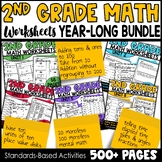Two Step Money Word Problems 2nd GR Counting Dollar Bills Coins Data Collection
Shanon Juneau We are Better Together
11.2k Followers
Grade Levels
2nd, Homeschool
Subjects
Resource Type
Standards
CCSS2.MD.A.1
CCSS2.MD.A.2
CCSS2.MD.B.5
CCSS2.MD.D.9
CCSS2.MD.D.10
Formats Included
- Zip
- Internet Activities
- Easel Activity
Pages
60 Pages plus Answer Keys
Shanon Juneau We are Better Together
11.2k Followers
Easel Activity Included
This resource includes a ready-to-use interactive activity students can complete on any device. Easel by TPT is free to use! Learn more.
Compatible with Digital Devices
The Teacher-Author has indicated that this resource can be used for device-based learning.
Also included in
- With over 500 pages of worksheets covering topics such as measurement, place value, 2 and 3 digit addition and subtraction, arrays, and word problems, this bundle provides a comprehensive set of materials that can be used for homework, classwork, or independent practice. SAVE 20% WITH THIS YEAR-LONPrice $44.00Original Price $56.00Save $12.00
Description
This 60 page worksheet set covers data collection, reading graphs, measurement and word problems with money. These 2nd grade math worksheets can be used to introduce a concept, review, assessment, homework, or center practice. Comes with answer key.
BUNDLED FOR CONVENIENCE!
These worksheets cover:
- data collection
- reading graphs
- line plots
- picture graphs
- bar graphs
- Counting coins
- Word problems with coins and bills
- Measurement
Other 2nd Grade Materials:
Main Standards Covered:
- 2.MD.A.1 Measure the length of an object by selecting and using appropriate tools such as rulers, yardsticks, meter sticks, and measuring tapes.
- 2.MD.A.2 Measure the length of an object twice, using length units of different lengths for the two measurements; describe how the two measurements relate to the size of the unit chosen.
- 2.MD.A.3 Estimate lengths using units of inches, feet, centimeters, and meters.
- 2.MD.A.4 Measure to determine how much longer one object is than another, expressing the length difference in terms of a standard length unit.
- 2.MD.B.5 Use addition and subtraction within 100 to solve word problems involving lengths that are given in the same units, e.g., by using drawings (such as drawings of rulers) and equations with a symbol for the unknown number to represent the problem.
- 2.MD.B.6 Represent whole numbers as lengths from 0 on a number line diagram with equally spaced points corresponding to the numbers 0, 1, 2, ..., and represent whole-number sums and differences within 100 on a number line diagram.
- 2.MD.C.8 Solve word problems involving dollar bills, quarters, dimes, nickels, and pennies, using $ and ¢ symbols appropriately. Example: If you have 2 dimes and 3 pennies, how many cents do you have?
- 2.MD.D.9 Generate measurement data by measuring lengths of several objects to the nearest whole unit, or by making repeated measurements of the same object. Show the measurements by making a line plot, where the horizontal scale is marked off in whole-number units.
- 2.MD.D.10 Draw a picture graph and a bar graph (with single-unit scale) to represent a data set with up to four categories. Solve simple put-together, take-apart, and compare problems1 using information presented in a bar graph.
WHO LIKES A DEAL?
- Follow me and be notified when new products are uploaded. New products are always 50% off for the first 24 hours they are posted (except for resources that are under $1.50). It pays to follow me!
QUESTIONS OR CONCERNS
- Email me at scjuneau@yahoo.com if you have any questions or concerns about this product.
Thank you for visiting my store! Please contact me if you have any questions!
I sure appreciate you!
Shanon Juneau ❤️
We Are Better Together
#2ndgrademathworksheets
Total Pages
60 Pages plus Answer Keys
Answer Key
Included
Teaching Duration
N/A
Report this resource to TPT
Reported resources will be reviewed by our team. Report this resource to let us know if this resource violates TPT’s content guidelines.
Standards
to see state-specific standards (only available in the US).
CCSS2.MD.A.1
Measure the length of an object by selecting and using appropriate tools such as rulers, yardsticks, meter sticks, and measuring tapes.
CCSS2.MD.A.2
Measure the length of an object twice, using length units of different lengths for the two measurements; describe how the two measurements relate to the size of the unit chosen.
CCSS2.MD.B.5
Use addition and subtraction within 100 to solve word problems involving lengths that are given in the same units, e.g., by using drawings (such as drawings of rulers) and equations with a symbol for the unknown number to represent the problem.
CCSS2.MD.D.9
Generate measurement data by measuring lengths of several objects to the nearest whole unit, or by making repeated measurements of the same object. Show the measurements by making a line plot, where the horizontal scale is marked off in whole-number units.
CCSS2.MD.D.10
Draw a picture graph and a bar graph (with single-unit scale) to represent a data set with up to four categories. Solve simple put-together, take-apart, and compare problems using information presented in a bar graph.







